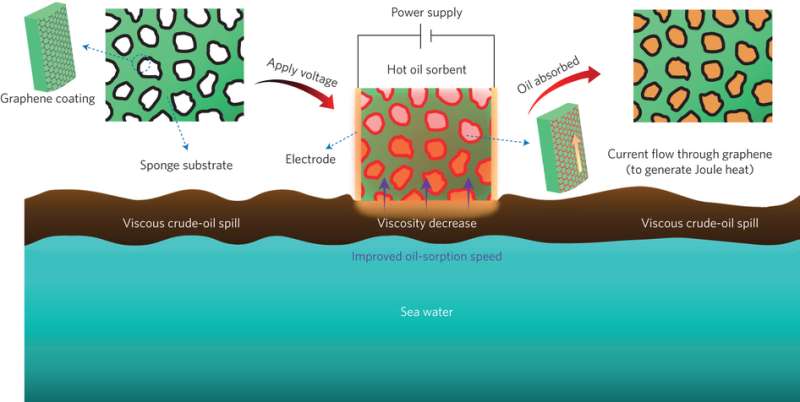April 4, 2017 report
Wrapping sponges in graphene nanoribbons allows for Joule heating to help clean up oil spills

(Phys.org)—A team of researchers with the University of Science and Technology of China has found a way to make sponges used to clean up oil spills in the ocean work better when soaking up heavy crude oil. In their paper published in the journal Nature Nanotechnology, the team describes how they wrapped polymeric sponges in graphene nanoribbons and then applied an electric current to cause the sponge to absorb the normally thick oil. Despina Fragouli and Athanassia Athanassiou with Istituto Italiano di Tecnologia in Italy offer a News and Views piece on the work done by the team in the same journal issue.
Oil spills are, of course, a serious problem with extracting oil from the ground or from beneath the ocean and shipping it for use in another location. Oil spills cause a lot of damage to the local ecosystem that can last for many years. In recent years, oil spills have happened less often, but when they do occur, they are worse than before due to the type of oil that is spilled. As medium and light crude oil reserves have been depleted, oil companies have turned to extracting heavy oil, which is more difficult to work with because it is so thick it does not flow very well—it also has low sorption, which means it is not pulled into sponges like other oils when it is spilled. In this new effort, the researchers have found a way to make conventional sponges better at pulling in such oils when leaks occur.
The new technique involves covering traditional sponges with graphene nanoribbons and then applying a small amount of current causing it to heat up by approximately 285 °C—prior research has shown that functional nanomaterials can make traditional porous materials better at removing low and medium viscosity oils from water. Using graphene as the nanomaterial takes advantage of the material's Joule heating properties, which warms the sponge and oil around it making the oil thinner and thus more able to be pulled into the sponge. Once the sponge absorbs as much as is possible, it is squeezed mechanically to remove the oil—that means that it can be reused several times, another advantage of the design. The team reports that the recovery rate for their sponge is 29 times that of non-heated sponges.
More information: Jin Ge et al. Joule-heated graphene-wrapped sponge enables fast clean-up of viscous crude-oil spill, Nature Nanotechnology (2017). DOI: 10.1038/nnano.2017.33
Abstract
The clean-up of viscous crude-oil spills is a global challenge. Hydrophobic and oleophilic oil sorbents have been demonstrated as promising candidates for oil-spill remediation. However, the sorption speeds of these oil sorbents for viscous crude oil are rather limited. Herein we report a Joule-heated graphene-wrapped sponge (GWS) to clean-up viscous crude oil at a high sorption speed. The Joule heat of the GWS reduced in situ the viscosity of the crude oil, which prominently increased the oil-diffusion coefficient in the pores of the GWS and thus speeded up the oil-sorption rate. The oil-sorption time was reduced by 94.6% compared with that of non-heated GWS. Besides, the oil-recovery speed was increased because of the viscosity decrease of crude oil. This in situ Joule self-heated sorbent design will promote the practical application of hydrophobic and oleophilic oil sorbents in the clean-up of viscous crude-oil spills.
Journal information: Nature Nanotechnology
© 2017 Phys.org


















